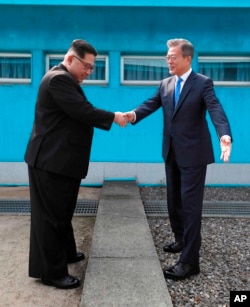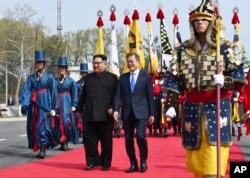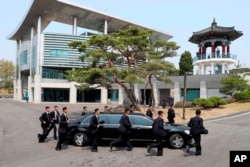The Inter-Korean summit began Friday morning with a historic step as North Korean leader Kim Jong Un crossed the military demarcation line that has divided Korea for over 60 years. At the end, the leaders of the communist North and Democratic South embraced prior to announcing a joint declaration committing to denuclearization and peace.
"Today, Chairman Kim Jong Un and I confirmed that the realization of the nuclear-free Korean peninsula through complete denuclearization is our common goal," said President Moon Jae-in at a ceremony to announce what they are calling the Panmunjom declaration.
The North Korean leader also endorsed the joint declaration as well as past inter-Korean agreements without elaborating or specifically acknowledging the agreed upon outcome to dismantle his country's threatening nuclear program.
"We have decided to open this transitional phase of improvement in relations and development by thoroughly implementing the North-South Declarations and all the agreements that have already been adopted," said Kim.
Historic crossing
Kim is now the first North Korean leader to cross into South Korea. He was greeted by Moon, who waited on the South Korean side of the borderline in the village of Panmunjom, the historic site, where the Korean War armistice was signed in 1953. The two leaders smiled as they shook hands across the border. Kim then stepped over the cement boundary marker.
Kim said he was, "excited to meet at this historic place" and later wondered "why it took so long" to get there.
"It really has a strong emotional impact on me," said Kim about the warm welcome he received from the people of South Korea.
President Moon welcomed Kim to the South and said he would like to one day visit North Korea. Laughing, the two together momentarily stepped over the border marker into the North's side of the demilitarized zone.
The two leaders posed for pictures with an unsmiling Kim dressed in a communist Mao-style suit and a smiling Moon in western business attire.
WATCH: Highlights from opening ceremony
They also agreed to continue efforts to improve relations that had grown increasingly tense over the North's continued nuclear and missile tests, especially accelerated efforts in the last two years to develop nuclear armed intercontinental ballistic missile (ICBM) capability to target the U.S. mainland.
"We declared together that there will be no more war on the Korean peninsula and that a new era of peace has begun," said Moon.
At the summit Moon and Kim conducted two rounds of meetings during the day, and the South Korean leader hosted a dinner that featured a variety of famous Korean dishes including Pyongyang-style cold noodles. Kim's wife, Ri Sol-ju, and sister Kim Yo Jong Un joined the delegations for dinner with Moon and his wife, Kim Jung-sook.
Diplomatic pivot
This year, Kim pivoted to embrace diplomacy and agreed to engage in negotiations to end his country's nuclear program. Both President Moon's diplomatic outreach to the North, and U.S. President Donald Trump's maximum pressure campaign, which imposed tough sanctions that block virtually all North Korean exports, and that emphasized the possible use of military force, are credited with compelling Kim to change his previous confrontational stance.
The joint declaration "confirmed the common goal of realizing complete denuclearization, and a nuclear free Korean Peninsula."
It also recognized as "meaningful and crucial," North Korea's recent unilateral concessions to suspend further nuclear and missile tests, and to close its Punggye-ri nuclear test site. However, some analysts have expressed skepticism that these measures are meaningful as they only freeze and not reduce the country's nuclear capabilities.
There were also indications that perhaps more serious diplomatic progress was being made away from the official talks when Moon and Kim engaged in what seemed to be a very candid conversation without any staff or advisers present as they sat together for 30 minutes outside the conference hall in the afternoon. Television cameras recorded the meeting from a distance.
Trump-Kim summit
The declaration is meant to prepare the diplomatic ground for the upcoming Trump-Kim summit, expected to be held in May or June. South Korean officials have assured the Trump administration that Kim is prepared to commit to completely and verifiably dismantling his nuclear program in exchange for security guarantees from the U.S., sanctions relief, and developmental assistance.
President Trump applauded the commitment to peace and denuclearization on Twitter, but added that "only time will tell" if the goals are achieved.
While Trump has expressed optimism that a nuclear deal with North Korea can be reached, he has said he will walk out of the meeting if there are signs it "is not going to be fruitful."
Given the unconventional nature of these summits, which come at the beginning and not the end of the negotiation process, and North Korea's past performance in breaking agreements, many remain skeptical that these high-level meetings will lead to real denuclearization progress.
"The devil is in the details and as we have found in the past, in three separate sets of negotiations with North Korea, the devil is always in the details," said Victor Cha, a North Korea scholar with the Center for Strategic and International Studies and a Professor at Georgetown University in Washington.
Peace treaty
Moon and Kim also agreed to work on measures to improve cross-border security, restart family reunions, and work toward replacing the longstanding armistice ending the Korean War in 1953 with a permanent peace treaty, which would also require the approval of the U.S. and China as signatories to the truce.
"I think there is room for North and South Korea to make progress on a peace settlement. That is fundamentally a Korean issue, including confidence building measures along the DMZ, [demilitarized zone], a declaration to end hostilities," said Gary Samore, a former White House arms control coordinator and director of the Belfer Center for Science and International Affairs at Harvard University's Kennedy School of Government.
After their historic talks, the leaders and their wives attended a banquet, along with Kim Jong Un's sister Kim Yo Jong. They raised a toast and were entertained by a variety of musical performances. Kim Jong Un bought Pyongyang-style cold noodles for the dinner, at the request of his South Korean counterpart. The starring role of the noodles led to long lines outside restaurants in South Korea's capital that were serving the dish.
This was the third inter-Korean summit, but the first to take place in South Korea. The meetings in 2000 and 2007 were held in the North.
Lee Youn-jee contributed to this report from Seoul.
















